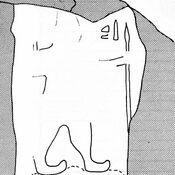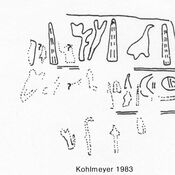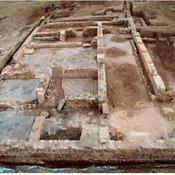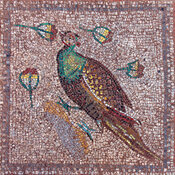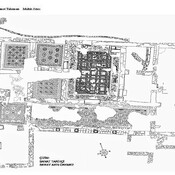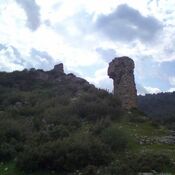Il n'y a pas une annotation en français. Présenté est une annotation en Anglais.
"... in Ionia there are two figures of this man carved upon rocks, one on the road by which one goes from the land of Ephesus to Phocaia, and the other on the road from Sardis to Smyrna. In each place there is a figure of a man cut in the rock, of four cubits and a span in height, holding in his right hand a spear and in his left a bow and arrows, ... and from the one shoulder to the other across the breast runs an inscription carved in Egyptian hieroglyphics, saying, 'This land with my shoulders I won for myself.' " Herodotus II.106.
The inscription indicates that this figure is a depiction of Hittite king Tarkasnava of Myra.
Tarkasnawa, King of Mira (land).
(Son of) Alantalli, King of Mira land.
Grandson of (...), King of Mira land.1
According to J. G. Macqueen the Rock relief of Karabel of the XIIIth centuryBC wasn`t a monument of the Hittite conquest but rather the work of local king2
- George E. Bean, Aegean Turkey., Ernst Ben, London 1966, p.55 nn.
- Ömür Harmanşah, Place, Memory, and Healing: An Archaeology of Anatolian Rock Monuments, Routledge 2014, p. 89
- J. G. Macqueen, The Hittites: And Their Contemporaries in Asia Minor, Thames and Hudson 1986, pp.24, 61, 148
- J. D. Hawkins, Tarkasnawa King of Mira ‘Tarkondemos’, Boǧazköy sealings and Karabel, Anatolian Studies 48, (1998) pp. 1–32
- idem, Hittite Monuments and Their Sanctity, in: Sacred Landscapes of Hittites and Luwians: Proceedings of the International Conference in Honour of Franca Pecchioli Daddi Florence, February 6th-8th 2014, p. 6
- idem, The Arzawa letters in recent perspective, British Museum Studies in Ancient Egypt and Sudan 14 (2009), pp. 73–83
- http://www.masseiana.org/sayce6.htm
- https://www.hethport.uni-wuerzburg.de/HPM/hpm-en.php?p=anfhet-en
- http://anatolianscripts.com/script/karabel-yazitlari/
Références
- ↑J. D. Hawkins, 1998
- ↑ J. G. Macqueen, The Hittites: And Their Contemporaries in Asia Minor, Thames and Hudson 1986, p.24
"... in Ionia there are two figures of this man carved upon rocks, one on the road by which one goes from the land of Ephesus to Phocaia, and the other on the road from Sardis to Smyrna. In each place there is a figure of a man cut in the rock, of four cubits and a span in height, holding in his right hand a spear and in his left a bow and arrows, ... and from the one shoulder to the other across the breast runs an inscription carved in Egyptian hieroglyphics, saying, 'This land with my shoulders I won for myself.' " Herodotus II.106.
The inscription indicates that this figure is a depiction of Hittite king Tarkasnava of Myra.
Tarkasnawa, King of Mira (land).
(Son of) Alantalli, King of Mira land.
Grandson of (...), King of Mira land.1
According to J. G. Macqueen the Rock relief of Karabel of the XIIIth centuryBC wasn`t a monument of the Hittite conquest but rather the work of local king2
- George E. Bean, Aegean Turkey., Ernst Ben, London 1966, p.55 nn.
- Ömür Harmanşah, Place, Memory, and Healing: An Archaeology of Anatolian Rock Monuments, Routledge 2014, p. 89
- J. G. Macqueen, The Hittites: And Their Contemporaries in Asia Minor, Thames and Hudson 1986, pp.24, 61, 148
- J. D. Hawkins, Tarkasnawa King of Mira ‘Tarkondemos’, Boǧazköy sealings and Karabel, Anatolian Studies 48, (1998) pp. 1–32
- idem, Hittite Monuments and Their Sanctity, in: Sacred Landscapes of Hittites and Luwians: Proceedings of the International Conference in Honour of Franca Pecchioli Daddi Florence, February 6th-8th 2014, p. 6
- idem, The Arzawa letters in recent perspective, British Museum Studies in Ancient Egypt and Sudan 14 (2009), pp. 73–83
- http://www.masseiana.org/sayce6.htm
- https://www.hethport.uni-wuerzburg.de/HPM/hpm-en.php?p=anfhet-en
- http://anatolianscripts.com/script/karabel-yazitlari/
Références
- ↑J. D. Hawkins, 1998
- ↑ J. G. Macqueen, The Hittites: And Their Contemporaries in Asia Minor, Thames and Hudson 1986, p.24
Hittite relief, mentioned by Herodotus





